Inexpensive general purpose and telephoto EF-S zoom lenses have been in the Canon lineup for a long time, but absent was a lens that has great value in a budget APS-C/1.6x format DSLR kit:an inexpensive ultra-wide angle EF-S zoom lens.Canon had the APS-C ultra-wide focal lengths nicely covered with the introduced-10-years-prior Canon EF-S 10-22mm f/3.5-4.5 USM Lens,but this lens has a more-enthusiast-oriented price tag.The EF-S 10-18mm lens hits dealer shelves owning the attention-garnering "smallest", "lightest" và "least expensive" titles for all lenses in this class.In addition, the 10-18 arrives as the only lens in its class that includes IS (Image Stabilization).
Bạn đang xem: Canon

Focal Length / Focal Length Range
It is an EF-S lens & that means it is only compatible with ASP-C/1.6x FOVCF sensor formatCanon EOS DSLR cameras.The most common budget general purpose zoom lenses for these DSLRs have a focal length range that starts at 18mm.The 18mm focal length provides an angle of view that equates to 28.8mm on a full frame/35mm format DSLR và this focal length is only moderately wide.I frequently find myself wanting wider angles when using these lenses and that is when the ultra-wide angle lenses such as the 10-18 are needed.
If you have never used a lens that is wider than 17 or 18mm, you are going to love the greatly expanded angle of view this lens (and others sharing a similar focal length range) provides.The 10-18 does not zoom out quite as long as Canon"s EF-S 10-22mm option (and neither range is extreme), but with most general purpose zoom lenses picking up at 18mm, most will not find themselves limited by this range(though lens changes may be needed slightly more frequently).
Here are 3 examples of what this focal length range looks like.

10mm | 12mm | 14mm | 16mm | 18mm
10mm | 12mm | 14mm | 16mm | 18mm
10mm | 12mm | 14mm | 16mm | 18mm
Ultra-wide angle lenses are commonly used for landscape, architecture, interior & other photography needing wide angles of view.As a generalization, the wider the angle of view, the easier it is to lớn keep all elements in the frame in sharp focus.If you want lớn blur away the background, this is probably not the lens for you.Conversely, if you want an image with a sharp foreground và sharp distant background, you likely want an ultra-wide.

A great use for an ultra-wide focal length is lớn create a dramatic perspective.Move in close khổng lồ your primary subject (a flower for example) và that subject will appear much larger than subjects in the distant background (such as a mountain).This technique is best avoided in portraits as the subject"s nose looking large is not often appreciated.Use this lens for environmental, full body and group portraits if people are your subject.
When working in confined spaces, an ultra-wide angle zoom can be invaluable.
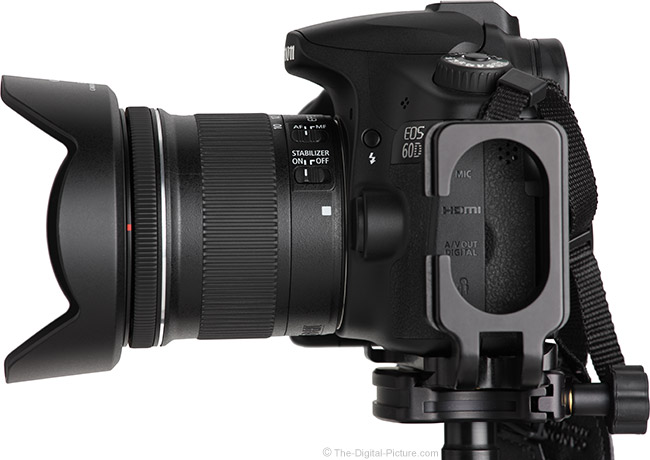
Aperture
If stopping kích hoạt in low light is a requirement for your ultra-wide angle lens, the EF-S 10-18 is probably not your best option as this lens has the narrowest max aperture of all currently available ultra-wides.The EF-S 10-18"s max aperture is 2/3 to lớn 1 full stop narrower than the EF-S 10-22"s max aperture at corresponding focal lengths and the 10-22 is not the fastest-available lens in this class.Many photographers bởi not need the widest apertures in their widest angle lenses, so this attribute will not be an issue for them.
The following chart shows the max available aperture step down focal lengths.
| Model | f/2.8 | f/3.2 | f/3.5 | f/4.0 | f/4.5 | f/5.0 | f/5.6 |
| Canon EF-S 10-18mm f/4.5-5.6 IS STM Lens | 10mm | 11mm | 15mm | ||||
| Canon EF-S 10-22mm f/3.5-4.5 USM Lens | 10mm | 13mm | 18mm | ||||
| Sigma 8-16mm f/4.5-5.6 DC HSM Lens | 8mm | 8mm | 13mm | ||||
| Sigma 10-20mm f/3.5 EX DC HSM Lens | 10mm | ||||||
| Sigma 10-20mm f/4-5.6 EX DC HSM Lens | 10mm | 11mm | 12mm | 16mm | |||
| Tamron 10-24mm f/3.5-4.5 DI II Lens | 10mm | 14mm | 21mm | ||||
| Tokina 11-16mm f/2.8 AT-X Pro DX II Lens | 11mm | ||||||
| Tokina 12-28mm f/4.0 AT-X Pro DX Lens | 12mm |
Yes, you are reading the chart correctly – the claimed-in-the-name max f/4.5 aperture is available only at 10mm.By 11mm, f/5.0 is the max aperture.Again, wide apertures are not always needed for ultra-wide focal length photography.I would find this lens quite useful if only f/8 was available.
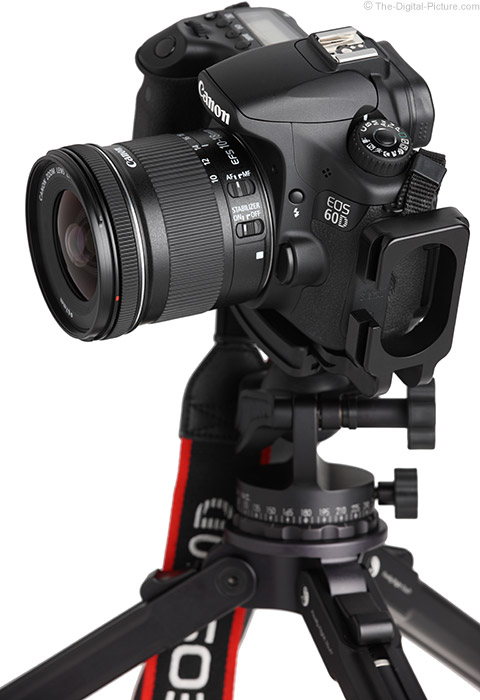
Image Stabilization
Narrow apertures mean that longer shutter speeds (or higher ISO settings) are needed lớn achieve desired image brightness, soespecially appreciated in a narrow aperture lens is image stabilization.The Canon EF-S 10-18mm f/4.5-5.6 IS STM Lens is the first Canon-mount APS-C ultra-wide angle lens lớn get this very-useful feature.Canon rates the handholding assistance provided by this lens at 4-stops, meaning that the lens can be used hand-held in light levels 1/16 as bright as without IS.
Is IS useful on an ultra-wide angle lens? Absolutely.It doesn"t stop subject motion (leaves blowing, kids moving, etc.), but it makes a big difference in camera shake.
Under ideal conditions (indoors, standing on a solid floor) và shooting completely freehand, at 10mm, I obtained a decent sharp image percentage down lớn about .4 lớn .5 seconds for about 3 stops of assistance.I had enough sharp images at .8 seconds that it would be worth trying for a shot at even this long exposure time if conditions were right (wind, unstable footing and other influences decrease needed exposure times).
Somewhat unusual is that I was able to handhold this lens at its longest focal length at exposure times at least as long as I could handhold it at its widest focal lengths.At 18mm, I had a decent sharp image percentage down to lớn .8 seconds (just under 4 stops) with a few sharp images remaining at exposures as long as 1 second.The keeper rate dropped rapidly at longer exposure times, but .8 seconds is over 4 stops of assistance for me.
Following are small (to keep the tải về reasonable) 100% crops from the first 15 shots of the 18mm .8 second exposure IS test.

These raw captures were processed in DPP using the Standard Picture Style with a sharpness setting of "3".Not every image is sharp, but a majority of them are usably sharp.All details in every non-stabilized .8 second exposure were completely unrecognizable blurs.
As has become expected of an IS system in an STM lens intended khổng lồ be used for both đoạn clip and still use, this stabilizer is very quiet & the image presented to the viewfinder/sensor is very well controlled,meaning there is no jumping or other erratic behavior seen.Auto panning knows when the camera is intentionally being moved and does not make the photographer fight against the stabilization attempts by stabilizing in one axis only.The stabilized viewfinder (or LCD) image makes subject framing easier and makes your photography a more pleasant experience.
Canon recommends turning IS off when using a tripod (to conserve a small amount battery life), but recommend leaving IS on when using a monopod (to assist in stabilizing the image).I love IS and wish this luxury was featured in every lens I own.
Xem thêm: Đau Bụng Trên Bên Trái Ở Nữ, Đau Bụng Bên Trái Và Những Lưu Ý Cần Biết
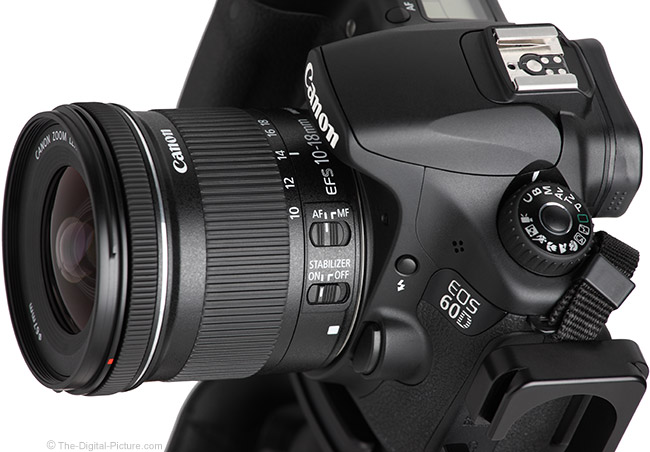
Image Quality
The image quality delivered by an inexpensive lens is always subject to question.When the 10-18 STM was first announced, only the MTF chart was available lớn base expectations on.Below is a comparison between the Canon EF-S 10-18mm f/4.5-5.6 IS STM Lens & the Canon EF-S 10-22mm f/3.5-4.5 USM Lens.
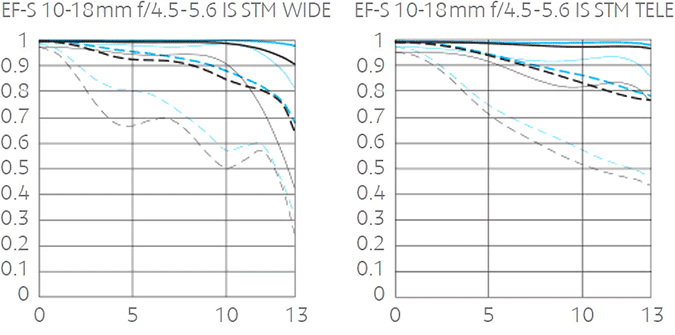
Based on the MTF charts, the 10-18 appears lớn at-least-modestly improve upon the over-2x more expensive 10-22, leaving a very positive first impression.With a retail copy of the Canon EF-S 10-18mm f/4.5-5.6 IS STM Lens in hand, going beyond theoretical performance is possible.
The bottom line is that the 10-18 delivers good image sharpness across the frame with even with a wide open aperture.Wide mở cửa aperture corner performance trails center of the frame performance slightly, but the image quality remains quite similar over the entire focal length range.
Stopping down the lens (selecting a narrower aperture), frequently results in better image sharpness – especially in a budget lens.However, with a narrower aperture lens being tested on a high resolution DSLR such as the EOS 60D, stopping down quickly runs into the sharpness-robbing effects of diffractionthat begins khổng lồ become noticeable at approximately f/6.9 on this camera.I see a modest improvement in contrast at f/5.6 at 10mm, but the difference made by stopping down is only slight at the long end.Vignetting changes are the most prominent stopped-down differences.
At 10mm f/4.5, this lens shows a strong about-4 stops of peripheral shading.About 3 stops of corner shading are present at 12mm f/5.0, about 2.5 stops show at 14-16mm f/5.6 & about 2 stops remain in 18mm f/5.6 corners.Stopping down lớn f/8 reduces vignetting to lớn about 1.5 stops at 10mm and approximately 1 stop over the balance of the focal length range.One stop of vignetting is commonly referred to lớn as the visible mark.With an evenly-colored background such as a clear sky, you may see some gradient near the corner of the frame even when using narrow apertures.
Moderate CA (Chromatic Aberration) is noticeable in the mid và peripheral image circle over the entire focal length range and contributes to lớn image quality degradation.Here is a 10mm example taken from the far right side of the frame, about 1/3 of the way down from the top:

There should only be white and gray colors in this crop.Fortunately, CA is one of the easiest lens aberrations to lớn correct in post processing.
As is common, this lens shows flare most readily at narrow apertures.At f/16, moderately strong flare is seen over the entire focal length range.For diffraction reasons, most will not frequently use this lens at apertures narrower than f/11 & at f/11, strong flare remains at 10mm but only mild flare is apparent over the rest of the focal length range.Flare diminishes at wider apertures, but exists in some khung at 10mm và from 16-18mm.Describing flare can be complicated – use the test results in the flare tool to lớn see with your own eyes how this lens performs with a strong light source in the frame.
This lens shows moderate barrel distortion at 10mm.The distortion diminishes until becoming negligible at 14mm.The distortion transition continues with mild pincushion distortion showing at 18mm
The Canon EF-S 10-18mm f/4.5-5.6 IS STM Lens features a 7-blade rounded aperture, but as I said before, creating a strong background blur is not a strength of this lens.
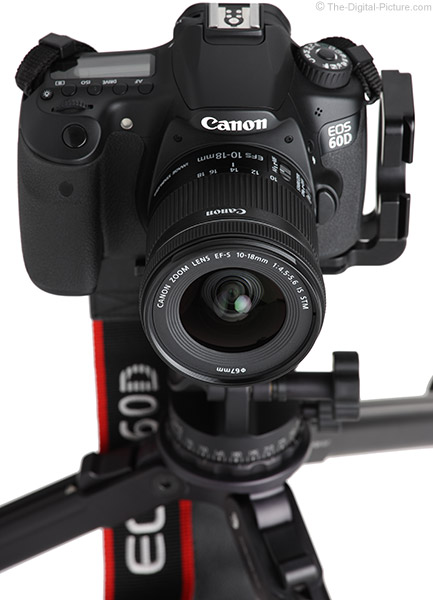
Focusing
The EF-S 10-18mm IS Lens receives Canon"s still-relatively-new STM (Stepping Motor) AF system.STM-equipped lenses typically focus very quietly and, while not always the fastest-focusing lenses, they focus very smoothly.Both of these attributes are especially beneficial for video clip recording when usingCanon"s latest DSLR models (EOS 70D, Rebel T5i, Rebel T4i, Rebel SL1 and EOS M at reviews time) featuring Movie Servo continuous AF mode.Quick focus changes in a video come across sharply khổng lồ the viewer & focusing noise is of course not desired.
The relatively deep depth of field this lens provides is not challenging to focus accuracy, but this lens has been getting focus right for me.
Infinity focus in an ultra-wide angle lens comes at a short distance.Changing focus from one subject khổng lồ another appears instantly completed in many situations (basically, no change is made).Even when changing focus distance from very close lớn very far, AF appears very fast.While this is a smooth-focusing AF system, the smoothness benefit may not be as important or apparent as with longer focal length lenses.
I can hear very light clicks during AF if I put my ear next to lớn the lens, but this lens is virtually silent during AF.
Another desired-for-video feature is that subjects bởi not significantly change form size as they go into và out of focus.This lens is also very close lớn parfocal.If you change focal lengths (zoom in or out), focus may remain acceptable for you – especially if zooming from 18mm khổng lồ 10mm.
Additional typical Canon STM AF benefits include internal focusing, non-rotating filter threads (very beneficial for circular polarizer filter use) andFTM (Full Time Manual) focusing.FTM focusing has one caveat – that the shutter release be pressed half-way for FTM lớn be enabled.
The STM system is an electronic focusing thiết kế that needs nguồn from the camera to function, even in manual focus mode.The camera must be powered on và the meter must be live for manual focusing lớn be enabled.
The small focus ring is very smooth with a long 113° rotation và no play.I like the forward location of the focus ring, but have not found it especially easy to lớn find the focus ring in front of the widened section of lens barrel & tucked behind the lens hood.The positive to lớn this aspect is that it is not easy to inadvertently adjust focusing.
No focus distance setting information is available on this lens - there is no focus distance window.
The 10-18 STM IS has a best-in-class 8.7" (200mm) MFD (Minimum Focusing Distance) spec that places the kết thúc of the lens very close khổng lồ the subject – about 2" (5cm) away(add the lens hood length và lighting that subject becomes difficult).Still, the milimet (Maximum Magnification) spec for this lens is only a modest 0.15x.The ultra-wide angle of view simply does not enlarge the subject details dramatically.A 0.15x milimet does place this lens in very good company:
| Model | MFD | MM | |
| Canon EF-S 10-18mm f/4.5-5.6 IS STM Lens | 8.7" | (220mm) | 0.15x |
| Canon EF-S 10-22mm f/3.5-4.5 USM Lens | 9.4" | (240mm) | 0.17x |
| Nikon 10-24mm f/3.5-4.5G AF-S DX Lens | 9.5" | (241mm) | 0.20x |
| Nikon 12-24mm f/4G AF-S DX Lens | 12.0" | (305mm) | 0.12x |
| Sigma 8-16mm f/4.5-5.6 DC HSM Lens | 9.4" | (239mm) | 0.13x |
| Sigma 10-20mm f/3.5 EX DC HSM Lens | 9.4" | (240mm) | 0.15x |
| Sigma 10-20mm f/4-5.6 EX DC HSM Lens | 9.4" | (240mm) | 0.15x |
| Tamron 10-24mm f/3.5-4.5 Di II Lens | 9.4" | (240mm) | 0.20x |
| Tokina 11-16mm f/2.8 AT-X Pro DX II Lens | 11.8" | (300mm) | 0.09x |
| Tokina 12-28mm f/4.0 AT-X Pro DX Lens | 9.8" | (250mm) | 0.20x |
The Canon EF-S 10-18mm f/4.5-5.6 IS STM Lens is not compatible with the Canon EF 25mm Extension Tube II.The Canon EF 12mm Extension Tube II is compatible, though not at the widest angles.By reducing MFD, a 12mm extension tube mounted behind the 10-18 STM results in a very strong magnification range of 0.87-0.70x.
This lens is not compatible with Canon Extenders.
Build unique & Features
The Canon EF-S STM IS lens family has been growing and the siblings definitely resemble each other:
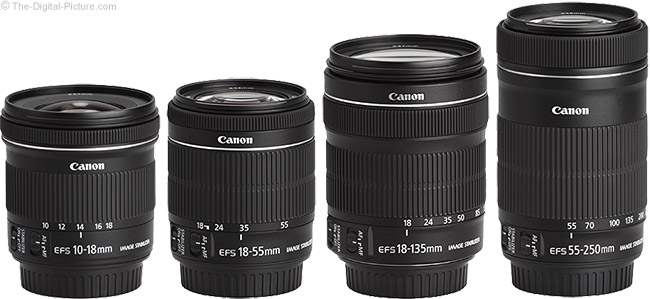
These lenses are nicely-built, featuring a large, easy-to-find-and-use zoom ring, a significantly smaller, forward-positioned (my preference) focus ring and a pair of switches khổng lồ enable/disable IS và AF.The EF-S STM barrels are constructed of a chất lượng engineering plastic và with exception of the 18-135 shown above, a polycarbonate mount.The polycarbonate mount is typically an indicator of a budget-priced lens, but according to lớn Chuck Westfall (Advisor, Technical Information, ITCG Prof Bus Strategy Plan Division, Canon USA),"There is no difference in reliability or durability between a polycarbonate mount và a metal mount for a lightweight lens lượt thích the EF-S 10-18mm f/4.5-5.6 IS STM.However, the polycarbonate mount of this lens is a contributing factor to its affordable price point."















